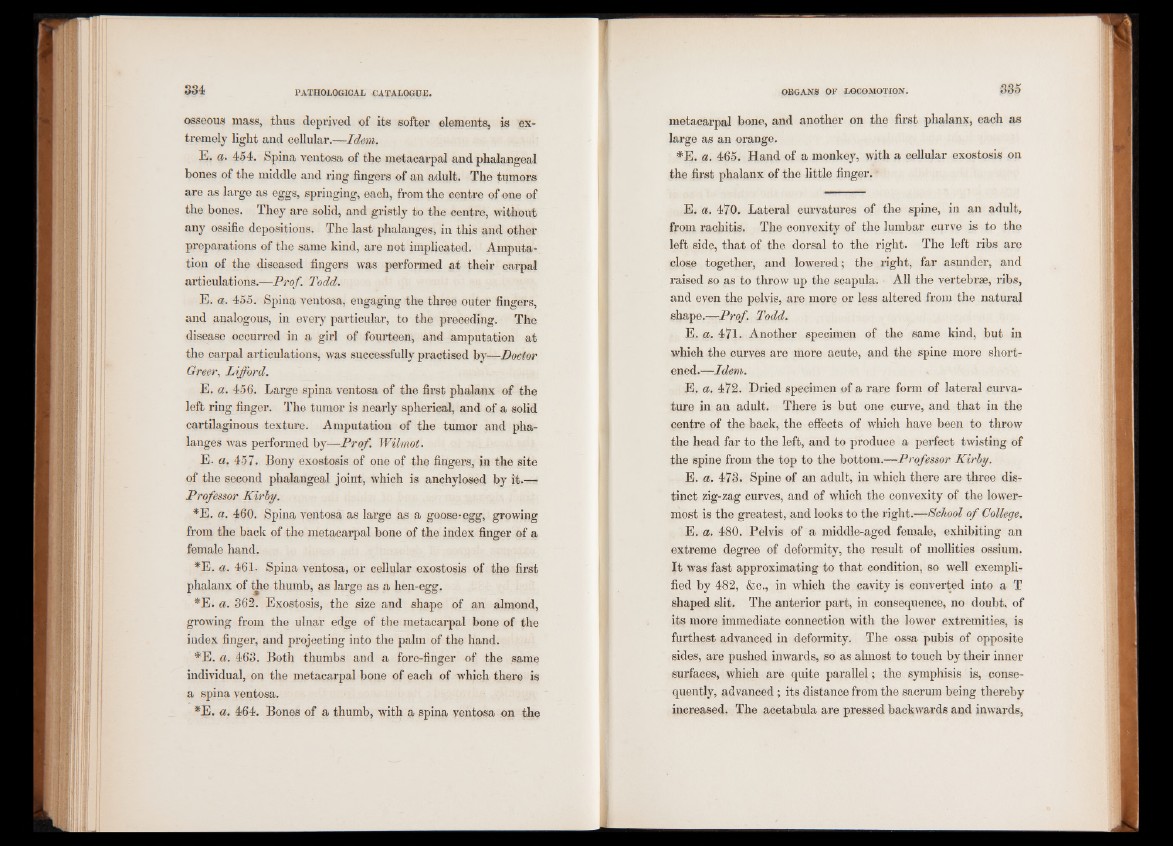
osseous mass, thus deprived of its softer elements, is extremely
light and cellular.—Idem.
E. a. 454. Spina ventosa of the metacarpal and phalangeal
bones of the middle and ring fingers of an adult. The tumors
are as large as eggs, springing, each, from the centre of one of
the bones. They are solid, and gristly to the centre, without
any ossifie depositions. The last phalanges, in this and other
preparations of the same kind, are not implicated. Amputation
of the diseased fingers was performed at their carpal
articulations.—Prof. Todd.
E. a. 455. Spina ventosa, engaging the three outer fingers,
and analogous, in every particular, to the preceding. The
disease occurred in a girl of fourteen, and amputation at
the carpal articulations, was successfully practised by—Doctor
Greer, Lifford.
E. a. 456. Large spina ventosa of the first phalanx of the
left ring finger. The tumor is nearly spherical, and of a solid
cartilaginous texture. Amputation of the tumor and phalanges
was performed by—Prof. Wilmot.
E. a. 457. Bony exostosis of one of the fingers, in the site
of the second phalangeal joint, which is anchylosed by it.—
Professor Kirby.
*E. a. 460. Spina ventosa as large as a goose-egg, growing
from the back of the metacarpal bone of the index finger of a
female hand.
*E. a. 461- Spina ventosa, or cellular exostosis of the first
phalanx of the thumb, as large as a hen-egg.
*E. a. 362. Exostosis, the size and shape of an almond,
growing from the ulnar edge of the metacarpal bone of the
index finger, and projecting into the palm of the hand.
*E. a. 463. Both thumbs and a fore-finger of the same
individual, on the metacarpal bone of each of which there is
a spina ventosa.
*E. a. 464. Bones of a thumb, with a spina ventosa on the
metacarpal bone, and another on the first phalanx, each as
large as an orange.
*E. a. 465. Hand of a monkey, with a cellular exostosis on
the first phalanx of the little finger.
E. a. 470. Lateral curvatures of the spine, in an adult,
from rachitis. The convexity of the lumbar curve is to the
left side, that of the dorsal to the right. The left ribs are
close together, and lowered; the right, far asunder, and
raised so as to throw up the scapula. All the vertebrae, ribs,
and even the pelvis, are more or less altered from the natural
shape.—Prof. Todd.
E. a. 471. Another specimen of the same kind, but in
which the curves are more acute, and the spine more shortened.—
Idem.
E. a. 472. Dried specimen of a rare form of lateral curvature
in an adult. There is but one curve, and that in the
centre of the back, the effects of which have been to throw
the head far to the left, and to produce a perfect twisting of
the spine from the top to the bottom.—Professor Kirby.
E. a. 473» Spine of an adult, in which there are three distinct
zig-zag curves, and of which the convexity of the lowermost
is the greatest, and looks to the right.—School of College.
E. a. 480. Pelvis of a middle-aged female, exhibiting an
extreme degree of deformity, the result of mollifies ossium.
It was fast approximating to that condition, so well exemplified
by 482, &c., in which the cavity is converted into a T
shaped slit. The anterior part, in consequence, no doubt, of
its more immediate connection with the lower extremities, is
furthest advanced in deformity. The ossa pubis of opposite
sides, are pushed inwards, so as almost to touch by their inner
surfaces, which are quite parallel; the symphisis is, consequently,
advanced; its distance from the sacrum being thereby
increased. The aeetabula are pressed backwards and inwards,